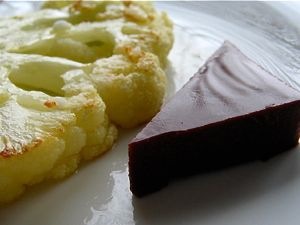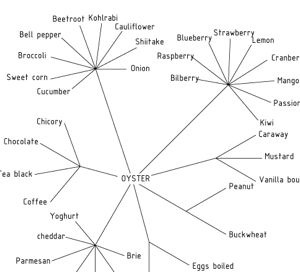
Blueberries and oysters? Chocolate and cauliflower? Blue cheese and rhubarb and pineapple?
If taste buds could cringe, then mine were recoiled into a wincing mess when I first learned about these flavor pairings. For those of you who have been eating at El Bulli or The Fat Duck or Alinea, this is all old news. For me, though, it was definitely an invitation to walk on the wild side.
To help wake up my outdated taste buds, my friend, Frankie, linked me up with Food for Design, where chemists and chefs and some overachieving web designers are putting together a provocative, highly entertaining website. With just a few minutes of clicking, creative and courageous cooks can find some very unusual food pairings.
Bernard Lahousse and Lieven De Couvreur in Belgium are the masterminds behind Food for Design. Based on the simple premise that “food combines with each other when they have major flavour components in common,” their postings attempt to pair foods according to their physicochemical properties. If two ingredients share common sequences or similar molecules, the thinking goes, then their overlapping flavor compounds will echo each other.
Even the simplest flavors that we perceive depend on hundreds if not thousands of molecules interacting. Heat, time, acid, oil, sun, salt—any number of things can change the bonds and the resulting shapes of these flavor compounds. Structural shifts lead to flavor changes. (Too much information, you say? Just ask any culinary student to summarize the Maillard Reaction to hear more than you ever wanted to know about the science of bread crust.)

Back to the fun stuff: My favorite pages are those with elegant tree diagrams tracing molecular groupings of common ingredients and the links between them that lead to not-so-common pairings. They’re perfect illustrations of form and flavor, the culinary equivalent of graphic designers’ never-ending debates about form and function. Keep exploring their pages to find such gems as: “Most people and even many engineers would guess that the shape of a raindrop is the familiar teardrop shape. However, the teardrop shape appears only in cartoons and the real shape is closer to the flattened hamburger bun.” Hence, the macaroon.
Later this week, I’m going to try making a cauliflower souffle with dark chocolate shavings, serve it to my guests, and see how long it takes them to figure out that they’re not eating white chocolate. If all goes well, I may have a recipe for you next week. Or not.
In the meantime, you can try a much simpler dish created by organometallic research chemist-slash-gourmand Martin Lersch: Caramelized Cauliflower and Chocolate Jelly.
Please do share your tasting notes!